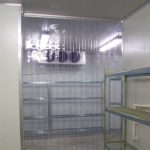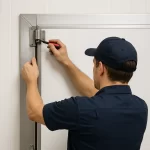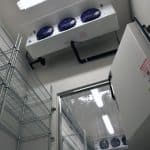How Do Door Closer Systems in Coolrooms and Freezers Work?
- 18 May 2017
Door closer systems use spring-loaded assemblies to hasten the sealing cycle. These are mechanically tensioned components, plus there are pneumatic and hydraulic variants available. To all appearances, the product looks like a plain hinge and its accompanying housing. On closer inspection, there’s some real fluid and mechanical muscle backing coolroom and freezer door closing mechanisms.
Assures Threshold Continuity
A strict binary configuration rules coolroom doors. That entryway is engineered to be either open or closed. When open, the catering worker quickly walks into the chilled enclosure, accesses the stored commodity, then he closes the door. If it didn’t close, there’d be trouble. In plain speaking terms, the precisely maintained arctic environment inside the chamber would be destroyed because the enclosure seal was no longer functioning properly. Design engineers use a two-part engineering strategy to maintain seal continuity. It all begins with the door hinges.
Two-Part Door Closer Systems
First of all, this isn’t an application that tolerates wide open doors. The design prevents loosely yawning doors by installing spring-loaded hinges. Alternatively, depending on the size of the walk-in entryway, solid stainless steel hinges are fitted to the door frame. Either way, the heavily insulated panel should swing closed with little effort. Next, there’re all kinds of overlapping sections that might stop the door from closing all the way. A thick gasket may be warped, a strip of frame insulation could be deformed, or some foreign matter could be stopping the door. Door closing systems use a special latching assembly to sidestep these situations.
Introducing Latching Mechanisms
Basically, the hook segment is fastened to the coolroom entry frame. A roller mechanism is installed on the door, with its housing exactly aligned opposite the hook. When coolrooms and freezers close their access portals, the roller section snaps home into the hook. Naturally, these are stainless steel parts, not weak metal components, so the door closer systems cope easily with spring-loaded hinges or manually applied force. Of course, a hydraulic dampening mechanism within the primary closer assembly helps to augment that robust feature.
Accurately installed door closer systems prevent the “cracked open” conditions we accept in our homes. In the home, that circumstance loses energy, and the homeowner receives a commensurately higher electricity bill. In walk-in coolrooms and freezers, such an event causes food spoilage and product loss, so the door closure device must function as described. Happily, some advanced closers do include an electrical feedback feature, so the central control panel will raise the alarm if the door isn’t seated.
Mark Connelly
C&M Coolroom Services
E-mail : markconnelly@cmcoolrooms.com.au
Mobile: 0412 536 315


